Major solar flare measuring X1.6 erupts, sends Earth directed CME
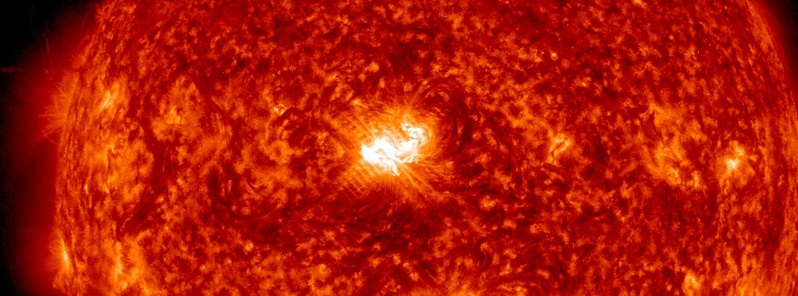
A major solar flare measuring X1.6 at its peak time erupted on September 10, 2014. The source was geoeffective Active Region 2158 located almost at the center of the disk. The event started at 17:21, peaked at 17:45 and ended at 18:20 UTC.
Coronal Mass Ejection (CME) was generated and is headed directly toward our planet.
A Type II (velocity 3750 km/s) and Type IV radio emissions were associated with the event. Type IV emissions occur in association with major eruptions on the sun and are typically associated with strong coronal mass ejections and solar radiation storms.
Additionally, a 10cm Radio Burst (tenflare) lasting 57 minutes with peak flux of 1300 sfu was associated with the event. A 10cm radio burst indicates that the electromagnetic burst associated with a solar flare at the 10cm wavelength was double or greater than the initial 10cm radio background. This can be indicative of significant radio noise in association with a solar flare. This noise is generally short-lived but can cause interference for sensitive receivers including radar, GPS, and satellite communications.
Region 2158, the source of today's X-class solar flare, has 'beta-gamma-delta' magnetic configuration and is capable of producing more strong to major eruptions on the Sun. It will remain in geoeffective position for the next couple of days. Any CME from that region will most likely be Earth directed.
NOAA SWPC forecasters estimate 85% chance for M-class and 40% chance for X-class solar flares in the next two days.
Update, September 11:
The CME is expected to pass the Earth's magnetosphere mid to late day on September 12h. It follows the September 9th CME which is expected to arrive early on September 12.
A G3 (Strong) Geomagnetic Storm Watch has been issued for September 13th due to the combined influence of these two events with G1 (Minor) storming anticipated to continue into September 14th.
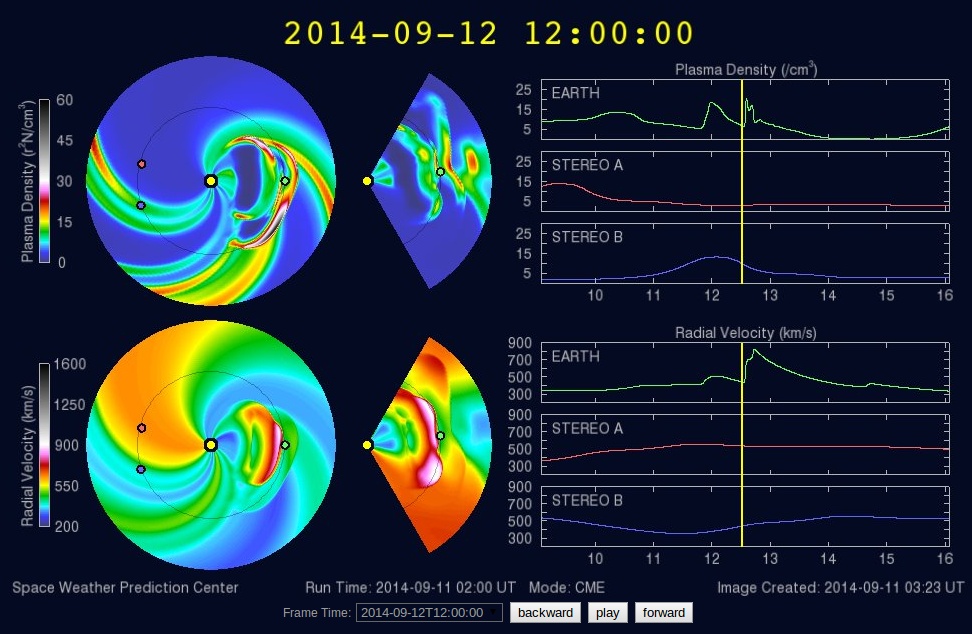
WSA-Enlil solar wind prediction. Check SWS-Solar Wind for updated model.
S1 (Minor) solar radiation storm is in progress as a result of the X1.6 eruption and is expected to persist for the next few days.
Alerts issued during and after X1.6 flare:
Space Weather Message Code: SUMX01
Serial Number: 103
Issue Time: 2014 Sep 10 1827 UTC
SUMMARY: X-ray Event exceeded X1
Begin Time: 2014 Sep 10 1721 UTC
Maximum Time: 2014 Sep 10 1745 UTC
End Time: 2014 Sep 10 1820 UTC
X-ray Class: X1.6
Optical Class: 2b
Location: N15E09
NOAA Scale: R3 – Strong
Potential Impacts: Area of impact consists of large portions of the sunlit side of Earth, strongest at the sub-solar point.
Radio – Wide area blackout of HF (high frequency) radio communication for about an hour.
***
Space Weather Message Code: SUM10R
Serial Number: 627
Issue Time: 2014 Sep 10 1903 UTC
SUMMARY: 10cm Radio Burst
Begin Time: 2014 Sep 10 1723 UTC
Maximum Time: 2014 Sep 10 1732 UTC
End Time: 2014 Sep 10 1826 UTC
Duration: 57 minutes
Peak Flux: 1300 sfu
Latest Penticton Noon Flux: 159 sfu
NOAA Space Weather Scale descriptions can be found at
www.swpc.noaa.gov/NOAAscales
Description: A 10cm radio burst indicates that the electromagnetic burst associated with a solar flare at the 10cm wavelength was double or greater than the initial 10cm radio background. This can be indicative of significant radio noise in association with a solar flare. This noise is generally short-lived but can cause interference for sensitive receivers including radar, GPS, and satellite communications.
***
Space Weather Message Code: ALTTP4
Serial Number: 477
Issue Time: 2014 Sep 10 1815 UTC
ALERT: Type IV Radio Emission
Begin Time: 2014 Sep 10 1728 UTC
Description: Type IV emissions occur in association with major eruptions on the sun and are typically associated with strong coronal mass ejections and solar radiation storms.
***
Space Weather Message Code: ALTTP2
Serial Number: 960
Issue Time: 2014 Sep 10 1814 UTC
ALERT: Type II Radio Emission
Begin Time: 2014 Sep 10 1727 UTC
Estimated Velocity: 3750 km/s
Description: Type II emissions occur in association with eruptions on the sun and typically indicate a coronal mass ejection is associated with a flare event.
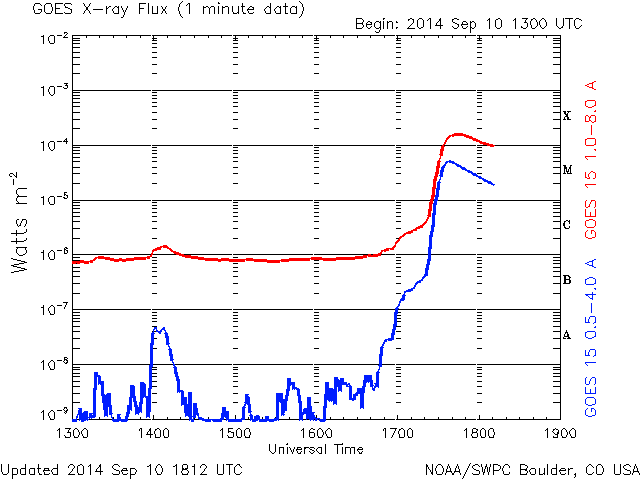
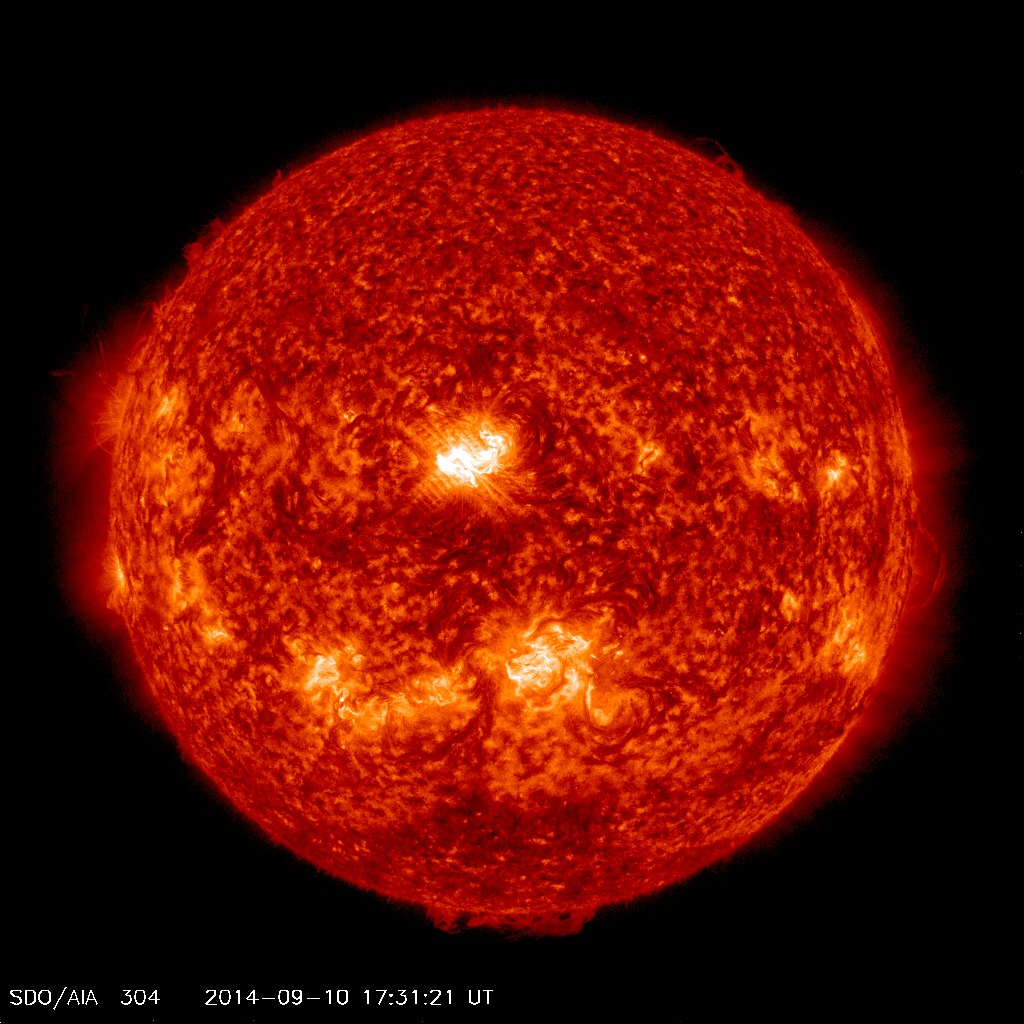
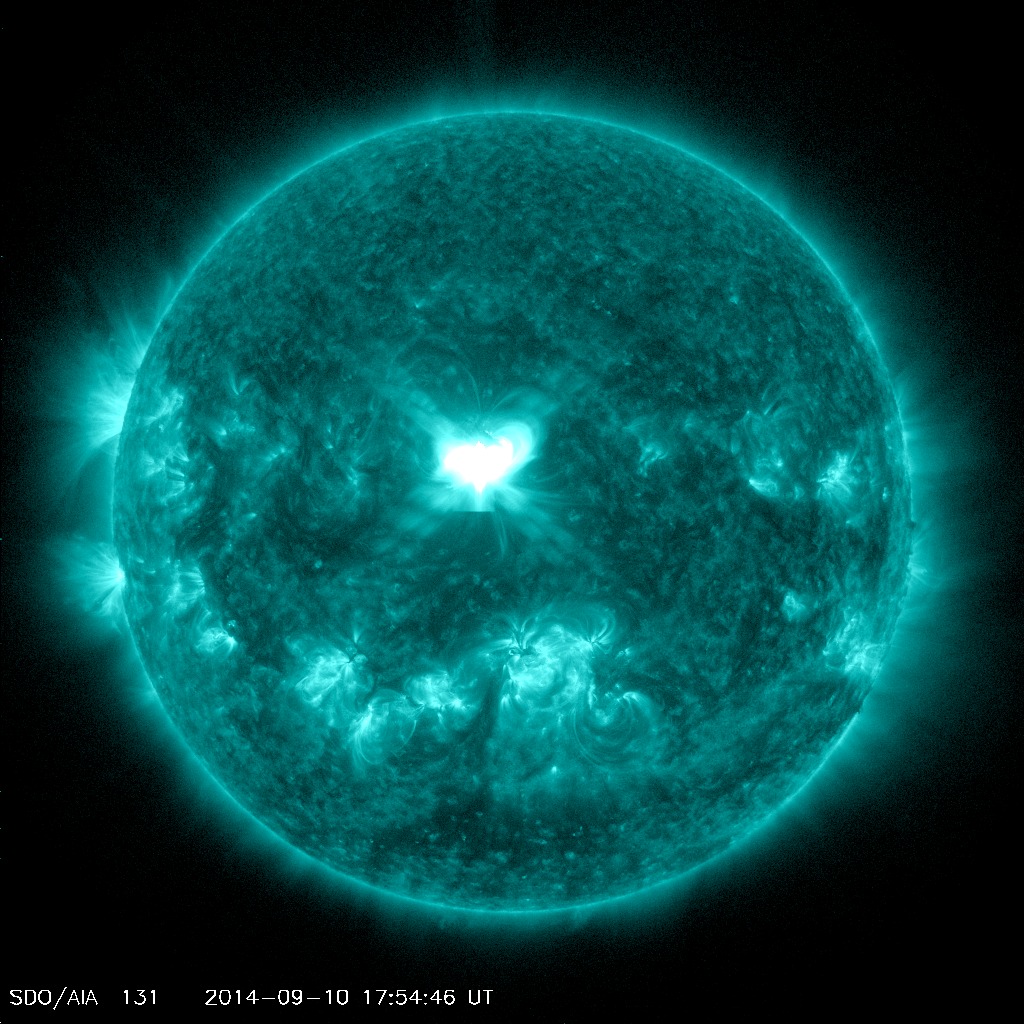
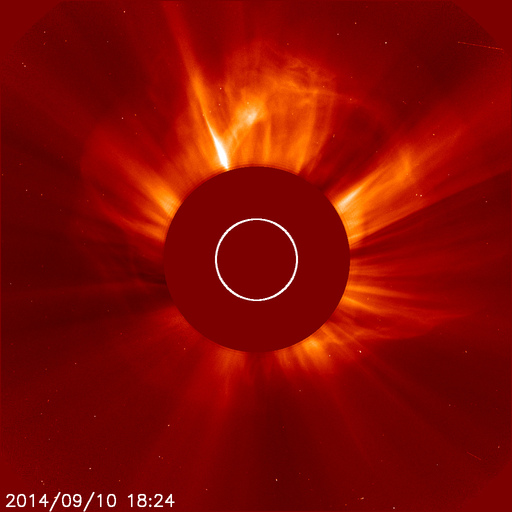
Image credit: NASA/ESA SOHO LASCO C2
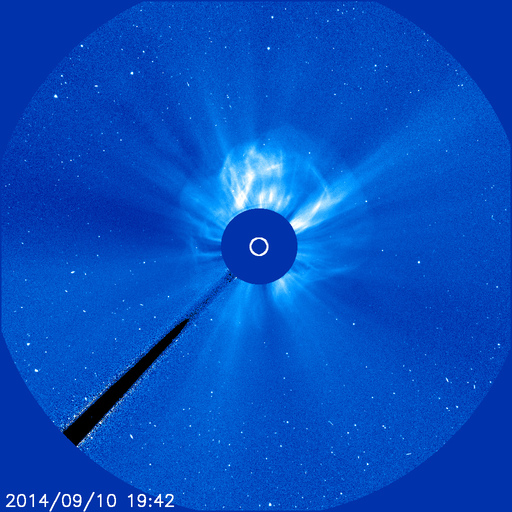
Image credit: NASA/ESA SOHO LASCO C3
Sunspots
There are currently 8 numbered sunspot regions on the disk. Regions 2157 and 2158 have 'beta-gamma-delta' magnetic configuration and continue to be areas of interest as they are still the largest and most magnetically complex regions on the visible disk. Both are almost directly facing Earth and should they produce CMEs they will most likely be Earth directed.
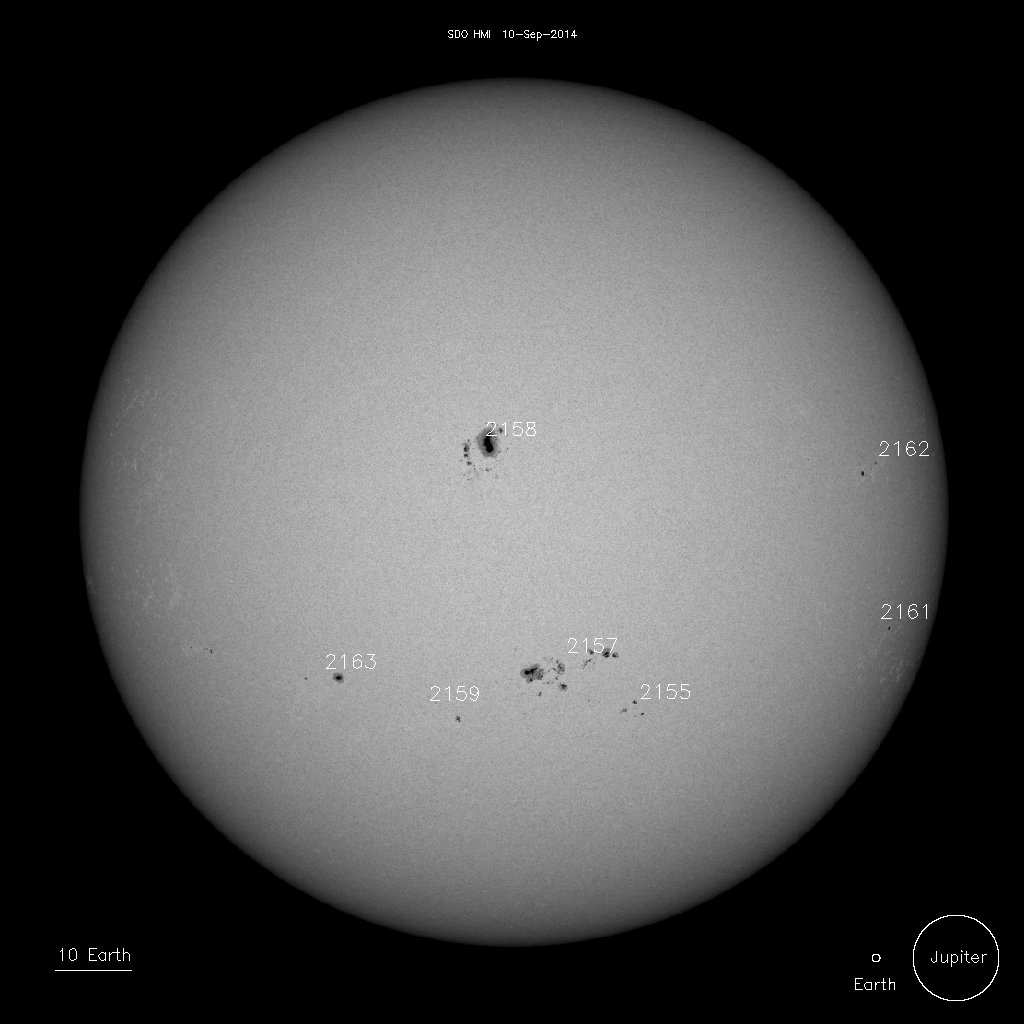
Sunspots on September 10, 2014. Image credit: NASA SDO / HMI
2152 – Alpha
2155 – Beta
2157 – Beta-Gamma-Delta
2158 – Beta-Gamma-Delta
2159 – Beta
2161 – Alpha
2162 – Beta
2163 – Beta
Geospace
Geomagnetic field was mostly quiet today but this will likely rapidly change on September 12th when the CME from September 9 is expected to impact Earth's magnetospere. Quiet to major storm (G2/Moderate) conditions are expected as a result.
Update, September 11:
G2 (Moderate) geomagnetic storms remain in the forecast for September 12th as a result of the coronal mass ejection (CME) associated with the R1 (Minor) solar flare observed on the 9th. The latest WSA-Enlil model run has the CME associated with X1.6 – R3 (Strong) solar flare arriving mid to late day on that same day.
A G3 (Strong) Geomagnetic Storm Watch has been issued for September 13th due to the combined influence of these two events with G1 (Minor) storming anticipated to continue into September 14th.
- For more information in near real-time visit our Space Weather Station.
Featured image: NASA SDO / AIA 304

Commenting rules and guidelines
We value the thoughts and opinions of our readers and welcome healthy discussions on our website. In order to maintain a respectful and positive community, we ask that all commenters follow these rules.